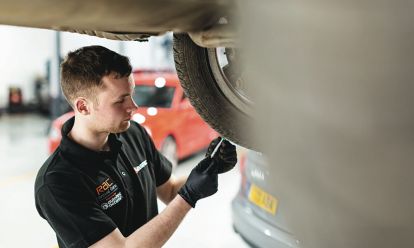So, what should you do if you’re confronted by road rage? Or perhaps you’re someone who lets your emotions run dangerously high behind the wheel?
To help answer these questions, here’s our driving advice guide to road rage and what you can do to ensure you get to your destination safely and calmly.
What is road rage?
Road rage is a catch-all term used to describe various types of aggressive and angry behaviour from drivers on the road. The term was first coined by US broadcasters back in the 1980s in response to shootings on the highway.
Thankfully incidents of road rage are rarely this severe. Road rage behaviour can range from rude gestures and verbal insults from behind the wheel, to dangerous or aggressive driving that intends to intimidate other road users.
What causes road rage?
As road rage is a broad term that relates to a range of behaviours, there is no single cause. But there are certain situations and driving behaviours that are more likely to lead to angry and frustrated drivers.
These factors are pretty easy to identify for most, but sometimes when you’re an aggressive driver looking to control your behaviour, you might not be able to immediately identify what set you off in the first place.
For example, people often get stressed when faced with crowded spaces and it’s no different on the road – roadworks and traffic jams are common triggers for hostile behaviour.
Because these factors are often an unexpected part of your journey, nasty surprises such as a long delay caused by roadworks can make road rage more likely.
Certain driving behaviours are also seen to be aggressive and dangerous on the roads:
- Hogging the middle lane
- Not letting you merge
- Merging at the last minute
- Parking across two bays
- Listening to loud music
- Not driving at the maximum speed limit
All of these and more seemingly innocuous driving mistakes can still trigger aggressive responses from other drivers. There’s a degree of separation that happens when we’re each in our cars as well - this can embolden drivers to show much more hostility than they would if they weren’t in the isolation of their own vehicle.

Cheaper than AA or we’ll beat by 20%^
• Roadside cover from £5.49 a month*
• We get to most breakdowns in 60 mins or less
• Our patrols fix 4/5 breakdowns on the spot

What are the signs of road rage?
The image of punch-ups at the side of the road comes to many people’s minds when they think of road rage, but in reality, there are a whole host of more subtle aggressive driving behaviours that cause unsafe situations:
- Speeding: Driving above the legal speed limit is the most common form of aggressive driving.
- Tailgating: Following too closely behind another vehicle can create an intimidating driving environment.
- Weaving through traffic: Impatient driving displayed by weaving through traffic is incredibly dangerous for all road users.
- Gesturing/shouting/staring: You may think that letting off steam in the safety of the driver’s seat is harmless but it can cause intimidation.
- Flashing headlights: Although this can act as a warning to road users, excessive flashing is intimidating and can blind other motorists.
- Sudden braking: Braking sharply in front of other vehicles is not only intimidating behaviour, it can also directly lead to collisions.
Service, repair or MOT?
You can trust the RAC with our local approved garages and NEW mobile mechanics.


How dangerous is road rage?
It can be very dangerous. Aggressive, angry motorists not only create an intimidating driving environment on the roads, their actions can also lead to collisions which can cause casualties and even fatalities.
Vulnerable road users such as pedestrians and cyclists are particularly at risk from such behaviour, while inexperienced or physically impaired drivers may be more intimidated by certain behaviours than other motorists.
Remember that you can never guess how another driver will react to your actions, whether you’re cutting them up or making rude gestures, so you never know when you could be putting yourself and others in danger.
Is road rage against the law?
Technically, ‘road rage’ itself is not an offence. But should road rage lead to aggressive driving then motorists may be found guilty of careless or dangerous driving which could see them fined, banned from driving, or even face jail time.
Similarly, should road rage lead to a physical confrontation then motorists could be arrested and charged with assault or other serious offences which could also lead to a prison sentence.
How do I know if I have road rage?

You’ll probably know if you get easily wound up behind the wheel and end up swearing or gesturing at other road users, or even trying to get back at other motorists you feel have acted inappropriately on the road.
However, some aggressive driving habits such as speeding or tailgating are more difficult to spot in your own driving so always make sure you’re following the speed limits and leaving sufficient distance between you and the car ahead.
How can I prevent road rage?
Should you find yourself susceptible to getting hot under the collar behind the wheel, there are certain things you can do to help keep your cool:
- Give yourself time: You might get stressed if you’re running late for work or an appointment, particularly if you’re stuck in traffic. Avoid getting angry with the clock and other road users by setting off earlier.
- Plan your route: If you don’t know where you’re going there’s more chance you’ll make mistakes on the road and get frustrated, so plan your journey ahead of time.
- Be understanding: We all make mistakes, so if a fellow motorist makes an error then take a deep breath and move on. Getting angry isn’t going to change what’s already happened.
- Let things go: It might be tempting to retaliate if another driver does something you find annoying, but you never know how someone else is going to react so don’t put yourself in unnecessary risk by reacting badly.
What should I do if I’m the victim of road rage?

If you’re the victim of aggressive and intimidating behaviour on the roads, it can be a worrying and even frightening experience, but following these steps will help ensure the situation doesn’t escalate:
- Stay calm: It might sound easier said than done, but if you’re faced with an aggressive driver try to stay calm and don’t panic. This may require pulling over for five minutes to cool off.
- Don’t retaliate: When targeted by an aggressive driver, it’s best to not retaliate (whether through words, gestures or driving actions) as it could make the situation far worse. Remember – you never know how someone else will react to your actions.
- Ignore them: If a driver is tailgating you or flashing their headlights, it’s always a safer option to simply let them past rather than changing your driving to suit them and putting yourself and other road users at risk.
- Acknowledge your mistakes: Whether or not you think you’re in the wrong, it’s often a good idea to simply recognise your mistake to try and diffuse the situation quickly.
How can I report an aggressive driver?
If another driver has made a minor mistake like pulling out in front of you there is no need to report it to the police. We’re all human, this is a mistake anyone could have made, so take a deep breath and make sure you don’t retaliate, then continue your journey.
However, if you’ve been victimised by an aggressive driver or even been assaulted by another road user, you should contact your local police force and file a complaint giving officers as many details as possible.
That said, be aware that a prosecution may not be possible without evidence supporting your claims from an independent witness or footage of the incident from CCTV or a dashcam, for example.
- Scared of driving – how can you overcome your fears?
- Fixed Penalty Notices: all you need to know
- RAC Temporary Car Insurance from 1 hour to 30 days
Does my car insurance cover road rage?
If you're involved in an incident with an aggressive driver and you think that their behaviour was a contributing factor, you should let your car insurance provider know.
That being said, some policies don't cover road rage incidents and those that do will be looking for evidence, so don't expect them to automatically take your word for it. Check your policy documents to find out if you're covered, and use dashcam/video footage if available.
If you're on the other side and your aggression led to a collision, it's possible that your provider may not pay out for any damage to your car.








